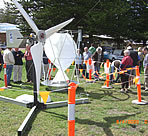Economical / Ecological Results
Massive price rises for traditional energy are inescapable. In 2012, 36 people out of every 1,000 in South Australia are being cut off for non payment. (see background Papers) Solar power is an enabling technology and approximately 75,000 South Australian houses are now saving money on their energy bills. But it's not just the money - for every kilowatt hour (kWh) generated - 1.06kg of CO2 is saved. This changes the status quo.
Economic Results
From March 2009 when C-PREP went live approximately 1,930 ratepayers entered the program. The statistics below are from the Fleurieu area which includes Kangaroo Island, Alexandrina, Yankalilla and Victor Harbor. One thousand ratepayers from Mt Barker, Adelaide Hills and the Barossa council areas jumped in behind C-PREP so the figures below could be doubled when those areas are included. It is to be remembered that the Federal Government shut the solar rebate program down approximately three weeks before its scheduled end of Jun 30, 2009. Had they not, the numbers would have been even more impressive.
- Over 700 Fleurieu ratepayers invest a minimum of $2,500.
- $5.76 m in Federal Government rebates attracted to the Fleurieu.
- ZEN installs a $20,000 local office.
- Three (3) local jobs created to staff it.
- 24 local electricians contracted for 9 month installation program.
- $50,000 in local newspaper advertising.
- $4,000 ZEN sponsors LGA Annual Conference.
- Ratepayer p/a power savings estimated at $250,000 annually.
- $88,000 raised via registration fees.
- $32,000 ZEN/Adelaide University/Victor Harbor partnership for renewable energy research “proof of concept” (solar/wind hybrid).
- ETSA gets $500,000 for new meters.
- Solar panels installed save approximately 1,584 tonnes of CO2 annually.
The C-PREP initiative has encouraged additional solar panel vendors (PVPs) into the market. Many have advertised in the local paper. This activity and the LGA initiative (based on Victor Harbor model) has seen the price of solar panels fall substantially over the last six months. So much so that the C-PREP 1.05 kWh system that Council enabled for $1,995.00 in 2009 can now be compared to a market driven 1.5kWh system available $2,999.00 which can be paid off over time.
All this activity is positive for the environment and the economy. Most importantly, at a time when all bills are increasing, your energy bill is now capable of being decreased. Indeed when you can afford it, and that might be sooner than later, with enough panels you can earn money from your investment.
Please remember that C-PREP is ongoing and we expect to have solar/wind hybrid prototypes early next year.
Ecological Results
November 2009
In all just over 2, 000 ratepayers across seven councils took advantage of the City of Victor Harbors solar panel retrofit.
Interestingly a large number of participants opted for systems much larger than the $1995 1.02kWh system offered. Some went as far as 17.2kWh systems.
For the 900 “ c-prepers” across the Alexandrina, Fleurieu and Kangaroo Island councils the carbon savings, based on the minimum system installed are 1,170 tonnes of CO2 annually.
The money saved annually on power bills is estimated at $250,000.
Of significance is the lessening demand on traditional coal fired plant. If renewable power usage continues to rise it could result in less need for the federal government to subsidise traditional energy suppliers.
These results are encouraging for our first effort. This page will be updated as more data becomes available.
Alternate Energy and Carbon Trading
issues It is abundantly clear that there are alternative, clean power sources. Equally clear is the need to deploy them at local level as traditional power generation methods, now threaten penury at a minimum and extinction at a maximum. Carbon trading will do nothing for us at local level. This offers Councils economic incentive and opportunity.
Click here for Full Paper: Carbon Trading Outline ![]() (PDF 79 KB).
(PDF 79 KB).





